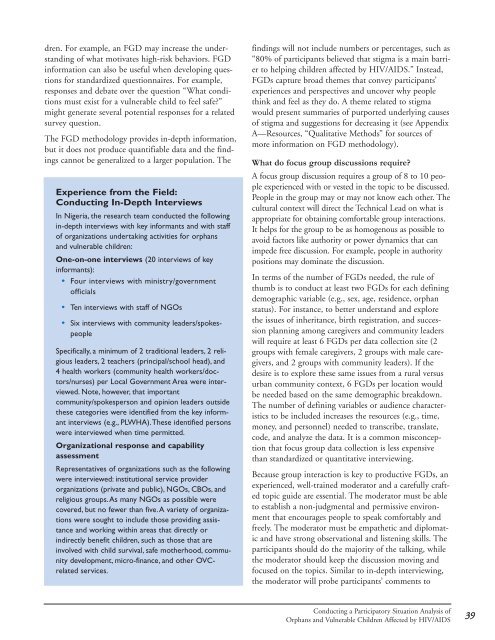Conducting a Participatory Situation Analysis of.pdf - Global HIV ...
Conducting a Participatory Situation Analysis of.pdf - Global HIV ...
Conducting a Participatory Situation Analysis of.pdf - Global HIV ...
You also want an ePaper? Increase the reach of your titles
YUMPU automatically turns print PDFs into web optimized ePapers that Google loves.
dren. For example, an FGD may increase the understanding<br />
<strong>of</strong> what motivates high-risk behaviors. FGD<br />
information can also be useful when developing questions<br />
for standardized questionnaires. For example,<br />
responses and debate over the question “What conditions<br />
must exist for a vulnerable child to feel safe?”<br />
might generate several potential responses for a related<br />
survey question.<br />
The FGD methodology provides in-depth information,<br />
but it does not produce quantifiable data and the findings<br />
cannot be generalized to a larger population. The<br />
Experience from the Field:<br />
<strong>Conducting</strong> In-Depth Interviews<br />
In Nigeria, the research team conducted the following<br />
in-depth interviews with key informants and with staff<br />
<strong>of</strong> organizations undertaking activities for orphans<br />
and vulnerable children:<br />
One-on-one interviews (20 interviews <strong>of</strong> key<br />
informants):<br />
• Four interviews with ministry/government<br />
<strong>of</strong>ficials<br />
• Ten interviews with staff <strong>of</strong> NGOs<br />
• Six interviews with community leaders/spokespeople<br />
Specifically, a minimum <strong>of</strong> 2 traditional leaders, 2 religious<br />
leaders, 2 teachers (principal/school head), and<br />
4 health workers (community health workers/doctors/nurses)<br />
per Local Government Area were interviewed.<br />
Note, however, that important<br />
community/spokesperson and opinion leaders outside<br />
these categories were identified from the key informant<br />
interviews (e.g., PLWHA).These identified persons<br />
were interviewed when time permitted.<br />
Organizational response and capability<br />
assessment<br />
Representatives <strong>of</strong> organizations such as the following<br />
were interviewed: institutional service provider<br />
organizations (private and public), NGOs, CBOs, and<br />
religious groups.As many NGOs as possible were<br />
covered, but no fewer than five.A variety <strong>of</strong> organizations<br />
were sought to include those providing assistance<br />
and working within areas that directly or<br />
indirectly benefit children, such as those that are<br />
involved with child survival, safe motherhood, community<br />
development, micro-finance, and other OVCrelated<br />
services.<br />
findings will not include numbers or percentages, such as<br />
“80% <strong>of</strong> participants believed that stigma is a main barrier<br />
to helping children affected by <strong>HIV</strong>/AIDS.” Instead,<br />
FGDs capture broad themes that convey participants’<br />
experiences and perspectives and uncover why people<br />
think and feel as they do. A theme related to stigma<br />
would present summaries <strong>of</strong> purported underlying causes<br />
<strong>of</strong> stigma and suggestions for decreasing it (see Appendix<br />
A—Resources, “Qualitative Methods” for sources <strong>of</strong><br />
more information on FGD methodology).<br />
What do focus group discussions require?<br />
A focus group discussion requires a group <strong>of</strong> 8 to 10 people<br />
experienced with or vested in the topic to be discussed.<br />
People in the group may or may not know each other. The<br />
cultural context will direct the Technical Lead on what is<br />
appropriate for obtaining comfortable group interactions.<br />
It helps for the group to be as homogenous as possible to<br />
avoid factors like authority or power dynamics that can<br />
impede free discussion. For example, people in authority<br />
positions may dominate the discussion.<br />
In terms <strong>of</strong> the number <strong>of</strong> FGDs needed, the rule <strong>of</strong><br />
thumb is to conduct at least two FGDs for each defining<br />
demographic variable (e.g., sex, age, residence, orphan<br />
status). For instance, to better understand and explore<br />
the issues <strong>of</strong> inheritance, birth registration, and succession<br />
planning among caregivers and community leaders<br />
will require at least 6 FGDs per data collection site (2<br />
groups with female caregivers, 2 groups with male caregivers,<br />
and 2 groups with community leaders). If the<br />
desire is to explore these same issues from a rural versus<br />
urban community context, 6 FGDs per location would<br />
be needed based on the same demographic breakdown.<br />
The number <strong>of</strong> defining variables or audience characteristics<br />
to be included increases the resources (e.g., time,<br />
money, and personnel) needed to transcribe, translate,<br />
code, and analyze the data. It is a common misconception<br />
that focus group data collection is less expensive<br />
than standardized or quantitative interviewing.<br />
Because group interaction is key to productive FGDs, an<br />
experienced, well-trained moderator and a carefully crafted<br />
topic guide are essential. The moderator must be able<br />
to establish a non-judgmental and permissive environment<br />
that encourages people to speak comfortably and<br />
freely. The moderator must be empathetic and diplomatic<br />
and have strong observational and listening skills. The<br />
participants should do the majority <strong>of</strong> the talking, while<br />
the moderator should keep the discussion moving and<br />
focused on the topics. Similar to in-depth interviewing,<br />
the moderator will probe participants’ comments to<br />
<strong>Conducting</strong> a <strong>Participatory</strong> <strong>Situation</strong> <strong>Analysis</strong> <strong>of</strong><br />
Orphans and Vulnerable Children Affected by <strong>HIV</strong>/AIDS<br />
39















